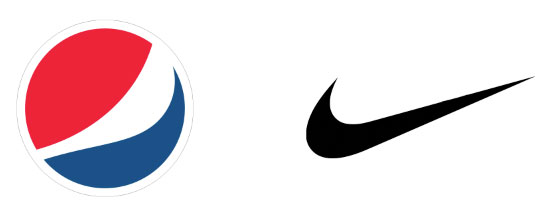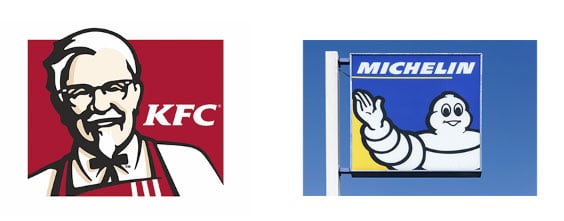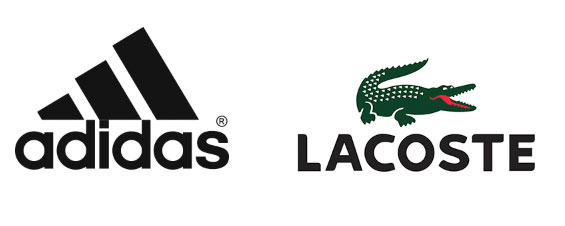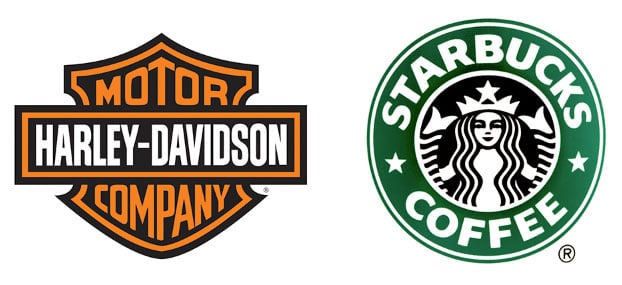We all know that a logo is the cornerstone of a business’s branding efforts. They are the visual symbol your customers remember and associate with your company.
Of course, you want to make sure it’s just right for this purpose. Perhaps the best starting point is to decide which of the 7 logo types is right for your business.
Didn’t know there are 7 different types of logo? You do now! Here’s a rundown of each to help you decide.
The 7 types of logo
Generally speaking, logos will involve text, images, or both. But it gets a bit more involved than that.
1. Lettermarks
Also known as a monogram logo, a letter mark consists of (you guessed it) letters. To keep things short and sweet, these logos rely on initialisms: the first letter of each word in the company name.
Think NASA, IBM, HBO, and so on. In fact, these logos are so strongly associated with their brands that many of us don’t even know what they stand for.
The fundamental part of a good lettermark is the font. Whether you design it yourself or pick a readymade one, it needs to stand out and be simple yet memorable. Just consider the branding potential of NASA’s logo.
Monogram logos are ideal for companies with long names – they help to make the company more memorable. After all, your customers only need to remember a few letters rather than something like International Business Machines Corporation (IBM).
2. Wordmarks
Workmarks, or logotypes, are a similar concept to lettermarks. As the name implies, they use a whole word (the company’s name).
They’re best for companies with a short, succinct brand name, usually one word. Think Visa or – better yet – Google.
Google arguably encompasses everything that’s right about wordmarks. They have a short, catchy business name and iconic typography. Pretty much anyone who’s been near a computer could describe their logo to you.
As with lettermarks, the right font is crucial. It should reflect your business: a fashion brand would use something elegant; a security firm, something bold and secure.
When to use
Lettermarks and wordmarks can be used in similar situations. You might be tempted to jump on either at this point, but hold off. Not every company will benefit from basing their logo around their name.
Consider these points:
• A lettermark is useful if you have a long business name.
• A wordmark is a good choice if you want people to remember your name, particularly if it’s distinctive.
• Both are easy to replicate and versatile across all marketing and branding strategies.
• Detail is vital: a clear font that reflects the nuance of your business is a must.
3. Pictorial marks
Also known as a logo symbol, a pictorial mark is just that: a picture or symbol. Customers being able to recognize your brand simply by seeing a picture is a sign of excellent marketing.
You probably don’t need many examples of this, but think Apple, Twitter, Snapchat, the World Wildlife Foundation; the list is endless.
Pictorial marks can be a reflection of your company name (again, Apple), a more abstract relation to your product’s function (the Snapchat ghost), or create an emotional response in your customer (the WWF panda).
This type of logo is arguably better suited to well-established brands, but even they started somewhere. However, Apple’s logo originally had text, so bear this in mind.
4. Abstract marks
An abstract logo is simply an image that isn’t something recognizable. Unlike a bird or apple, they’re things like Pepsi’s circle, Nike’s swoosh, or Adidas’s… thing.
Abstract logos offer a lot of freedom but also require plenty of work to establish the right feeling in your consumer. Sometimes this can be more straightforward: the Nike logo symbolizes movement. Other times it’s a bit more challenging (Pepsi’s logo, for example).
Again, the key here is cultivation of emotion in the minds of your consumers. Therefore, abstract marks require solid marketing plans and commitment.
5. Mascot logos
Simply put, a mascot logo is a character that becomes associated with your brand. By including them in your marketing campaigns, the link is immediate and recognizable. What’s more, it gives you a free spokesperson for your brand.
Some examples include the KFC colonel, Mr. Peanut from Planter’s, the Michelin Man, even Mickey Mouse.
Mascots are fun, often cartoon-based, and can appeal to adults and children in equal measure.
When to use
Mascots, pictorial marks, and abstract marks offer similar pros and cons. Consider these points:
• Abstract and pictorial marks are useful if you have a long brand name.
• However, they can be tricky if you’re a new business. Getting to the point where customers know your image takes time and money.
• All 3 are useful if you want to do international (or multi-language) business and your name doesn’t translate well.
• Mascots offer a massive range of marketing potential, particularly towards families.
6. Combination marks
You can probably guess by now what a combination mark is. Simply put, it’s a combination of text and image. There are different methods of combining them, including using the text within the pictorial image.
Take, for example, Pringles, Burger King, and Doritos. All offer iconic brand images that you immediately recognize.
They offer versatility and a good way to begin the association between your brand name and its chosen image. Apple and Twitter are both examples of this. Over time, they phased the text out because people know who they are.
Combination marks are a good choice for new businesses that want their brand image to be primarily picture-based, either now or in the future.
7. Emblems
An emblem is basically the more classical version of a combination mark. They include text and image; the text may be as simple as the business name, or might include a slogan.
Starbucks is a good example, as is almost any automotive company or school. Emblems are striking and rely on their traditional appearance to establish a feeling of trust in their consumers.
Emblems often require high levels of detail, which can restrict their marketing potential slightly. If you want something striking on a business card, for example, an emblem might not be the right choice.
However, you can overcome this by keeping your emblem design bold and striking. Think Harley Davidson, which is widely known to work well on clothing and smaller items.
When to use
Emblems and combination marks share similarities in their appearance but differ in use. Consider:
• A combination mark is great for new businesses because they’re easy to make unique.
• What’s more, they quickly establish a link between a visual and your company name.
• Emblems have the potential to be popular, but you need to put a lot more work into the design to keep them simple yet full of impact.
Conclusion
Hopefully one of the 7 types of logo will be the right fit for your brand.
But if it sounds like a challenge to pick the right one, contact Gee Productions. We’re happy to set you up with a logo that truly reflects your brand.
Our consultations are free and we’ll go over everything we need to get started.













